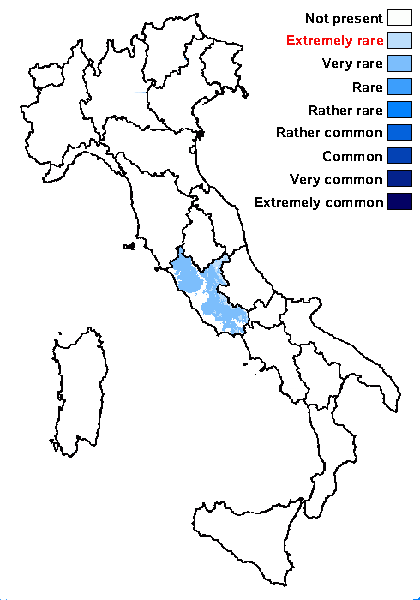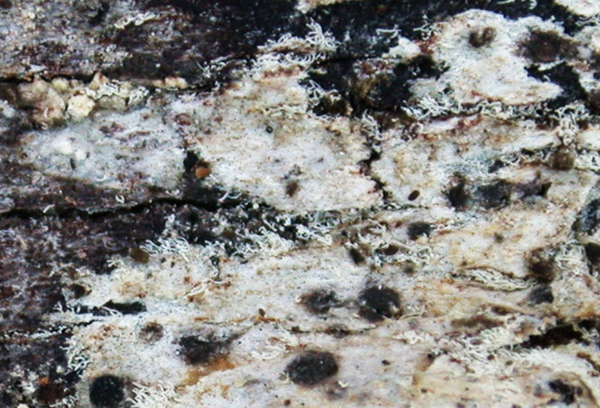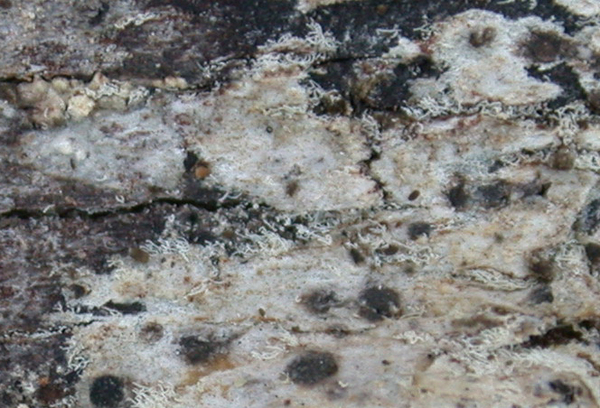Thelenella justii (Servít) H. Mayrhofer & Poelt
Herzogia, 7: 61, 1985. Basionym: Microglaena justii Servít in Zschacke - Rabenh. Krypt.-Flora, 9, 1: 665, 1934.
Synonyms:
Distribution: C - Laz.
Description: Thallus crustose, endosubstratic or very thinly episubstratic, dirty white, granulose and almost pseudoisidiate, without a distinct prothallus. Perithecia scattered, immersed and hardly visible, globose, up to 0.5 mm across, pale, with a centrally located, pale reddish brown ostiole. Exciple colourless, 2-layered, the outer layer prosoplectenchymatous, the inner layer finely paraplectenchymatous with small cells; paraphysoids thread-like, c. 0.5 μm thick, sparingly branched and anastomosing; hymenial gel I-, K/I-. Asci 2(-8)-spored (only 2 spores well-developed, the others aborting early), broadly cylindrical, fissitunicate, with two functional wall-layers, the inner wall thin and the outer thick, without a distinct ocular chamber, K/I-. Ascospores submuriform to muriform, with 11-15 transverse septa and 1-2 longitudinal septa, hyaline, elongate-ellipsoid to fusiform, with pointed ends, (27-)35-46(-50) x (9-)12-16(-18) μm, the outer wall scarcely thicker than the septa. Pycnidia immersed, resembinlg small perithecia, up to 0.3 mm across, the wall prosoplectenchymatous, pigmented in inner part. Conidia thread-like, hyaline, curved, 11-17 x c. 0.5 μm. Photobiont chlorococcoid, the algal cells without a gelatinous sheath. Spot tests: K-, C-, KC-, P-, UV-. Chemistry: without lichen substances.
Note: a mild-temperate lichen described from Greece (on the bark of Abies cephalonica) and also known from France, Spain and Algeria, found on the bark of broad-leaved, rarely of coniferous trees in sheltered situations, with optimum in the Mediterranean-montane belt, descending to the Mediterranean belt in particularly humid areas of Tyrrhenian Italy. It was included in the Italian red list of epiphytic lichens as “Data Deficient” (Nascimbene & al. 2013c).
Growth form: Crustose
Substrata: bark
Photobiont: green algae other than Trentepohlia
Reproductive strategy: mainly sexual
Most common in areas with a humid-warm climate (e.g. most of Tyrrenian Italy)
Commonnes-rarity: (info)
Alpine belt: absent
Subalpine belt: absent
Oromediterranean belt: absent
Montane belt: extremely rare
Submediterranean belt: absent
Padanian area: absent
Humid submediterranean belt: very rare
Humid mediterranean belt: very rare
Dry mediterranean belt: absent

Predictive model
Growth form: Crustose
Substrata: bark
Photobiont: green algae other than Trentepohlia
Reproductive strategy: mainly sexual
Most common in areas with a humid-warm climate (e.g. most of Tyrrenian Italy)
Commonnes-rarity: (info)
Alpine belt: absent
Subalpine belt: absent
Oromediterranean belt: absent
Montane belt: extremely rare
Submediterranean belt: absent
Padanian area: absent
Humid submediterranean belt: very rare
Humid mediterranean belt: very rare
Dry mediterranean belt: absent

Predictive model
 INDEX FUNGORUM
INDEX FUNGORUM
 GBIF
GBIF



